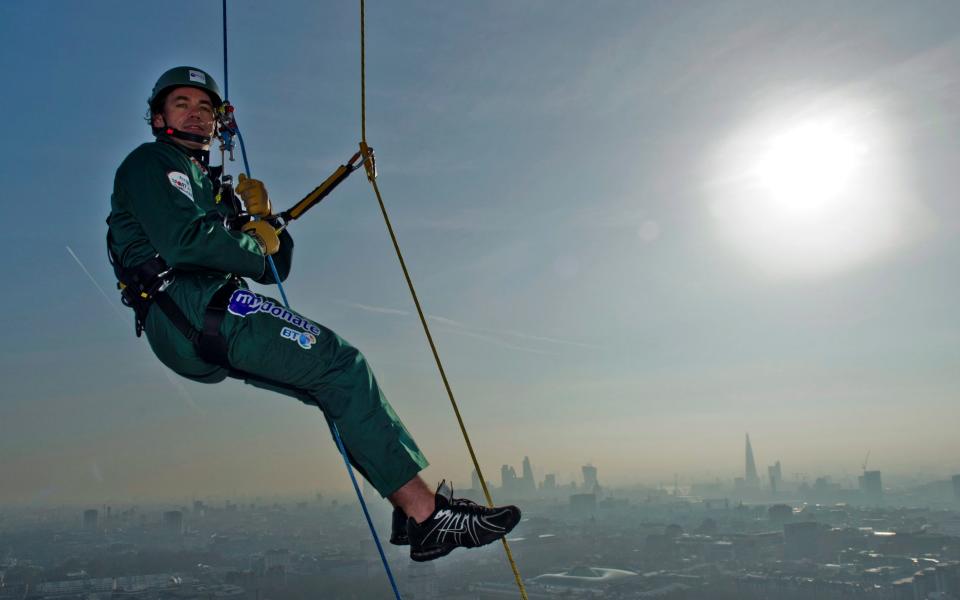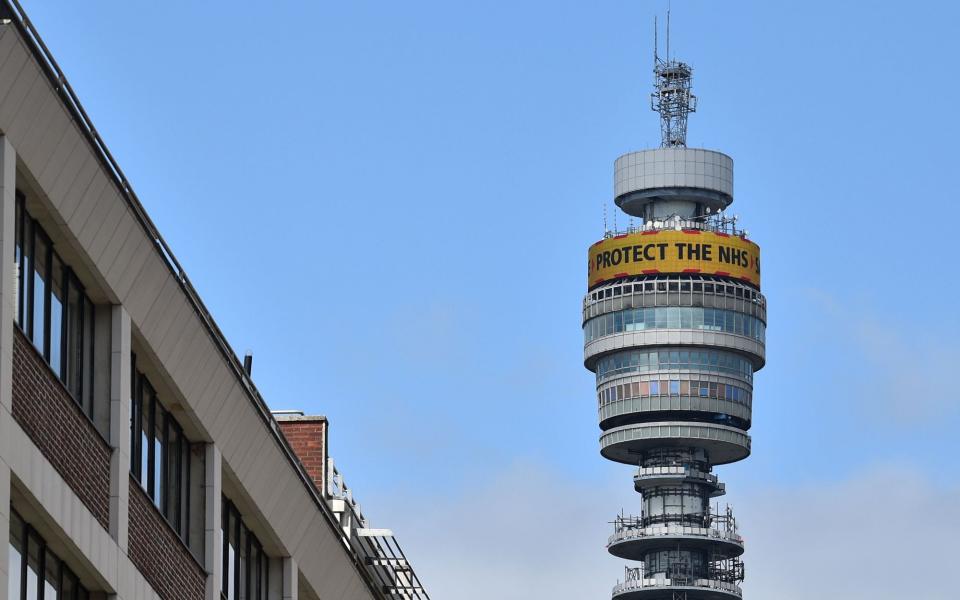For Gavin Patterson, abseiling down the BT Tower is a memorable highlight of his time as chief executive of the telecoms behemoth.
The stunt, performed with TV adventurer Bear Grylls, was just one in a series of charity events organized in London over the years.
But the BT Tower will now begin a new life as a hotel after BT struck a £275m deal to sell the building to a US-based hotel chain.


The skyscraper, originally known as the Post Office Tower, was born out of necessity, beginning its life as a vital hub for broadcasting television and telephone signals across the UK.
But as these services migrated to more modern networks, the purpose of the landmark shifted from being functional to symbolic – and became a constant headache for BT bosses.
In the modern world, the building’s technological value is limited according to former BT chairman Sir Mike Rake, who describes it as an “iconic white elephant”.
The Grade-II listed tower in Fitzrovia was completed in 1964 and opened for operations by Prime Minister Harold Wilson the following year, before former master general Tony Benn gave the go-ahead to the public in 1966.
For Benn, the project was a sign that a new Britain was emerging from the ashes of war – a project representative of his time as the Elizabeth Tower where Big Ben lives.
“Big Ben represents the majesty of the Gothic revival that represented the Victorian imperial wealth, based on the origins of the first Industrial Revolution,” he said.
“Slim, practical and futuristic, the Post Office Tower symbolizes the technical and architectural skill of this new century.”
Rising 189 meters above London, it was the tallest building in the UK until 1980, when it was replaced by the NatWest Tower in the City of London.
The tower was open to the public until 1971 and housed a restaurant on the revolving top floor, operated by resort owner Butlin’s.
Public access ended that year when a suspected IRA bomb exploded on the 31st floor. No one was injured in the attack, but it took two years to repair the damage. The restaurant closed nine years later in 1980 when its lease expired.
Since 1984, the room located at the top of the tower has been used by BT as a corporate hospitality space and for charity events.
In 2009, the tower’s 360-degree LED screen, known as the “information band”, was launched. It was used to show the countdown to the London 2012 Olympics, as well as carry messages during national events such as the pandemic.
In recent years the building, which was technically classified under the Official Secrets Act until 1993, has only opened its doors to the public for special events.
In 2015, the revolving restaurant reopened for one night, and in 2018 four guests were given a one-time opportunity to glamp on the skyscraper’s 34th floor.
Patterson, BT’s chief executive at the time, hailed the building as a “unique feat of engineering” on its half-century and added: “It has been a working icon of technological innovation for 50 years.”
Behind the publicity stunts, however, was a less glamorous story.
Apart from a sophisticated control room on the lower floors, much of the building has been empty for years. Its microwave antennae, an integral part of the structure’s design, were removed over a decade ago.
As a result, successive BT bosses are at a loss as to what to do with the landmark.


Bosses tried to reopen the restaurant, but this was always vetoed due to security concerns.
The company has also previously fielded takeover interest from Middle Eastern investors, but disagreements over valuation and concerns over the difficulty of extracting leftover equipment from any potential deal have dogged it.
Patterson describes the process as “a huge undertaking”.
“With every chief executive, I’m sure we’ve all looked at it at one point or another, but it’s always been in the ‘too hard to do’ pile,” he says,
“I think it’s a good move because eventually something has to be done with the building. It’s a credit to him for doing the job.”
As part of the agreement, hotel company MCR will make staged payments as the remaining equipment is removed from the building.
“The proposal to turn BT Tower into a hotel shows that it is possible to find new uses for perhaps even the most iconic of listed buildings,” says Henrietta Billings, director of SAVE Britain’s Heritage, which campaigns to find new uses for historic buildings.
“Done right, this could be one of London’s most exciting new destinations. We look forward to seeing the plans unfold with interest.”
The move to sell the tower comes in the first weeks of Allison Kirkby’s tenure as chief executive, although finance chief Simon Lowth is likely to have pushed the deal through.
It comes amid wider cost-cutting at BT, which has announced plans to cut 55,000 jobs by the end of the decade in a bid to squeeze £3bn out of the business.
Although £275m is a relatively small sum for a company of BT’s size, the savings on running costs are likely to be significant.
In 2019, BT sold its former BT Center headquarters for £210m and moved into a new building in Aldgate. He has also set out plans to reduce the number of offices in his estate from more than 300 to around 30.
Bosses are likely to be scrutinizing the group’s property portfolio across the country, particularly former telephone exchanges, for a possible sale.
For the BT Tower, the sale promises a new lease of life under the control of MCR Hotels, the third largest hotel owner in the US, which operates sites including the TWA at JFK Airport and the Sheraton in Times Square.
The MCR is led by Tyler Morse, a veteran hotel executive who began his career in the hospitality industry as a baggage handler, ski instructor, bus boy and valet.
The company has given little information about its plans for the project, which include a “podium” of buildings covering an entire block in addition to the tower.
However, MCR has said it will partner with Heatherwick Studio, the London-based architecture firm behind projects including the Coal Drops Yard in King’s Cross and the Vessels structure in New York.
Thomas Heatherwick, founder of the studio, said it was “an extraordinary building and a great opportunity to bring it back to life”.
Naomi Nettleton, real estate partner at law firm Charles Russell Speechlys, says there is a “growing trend of repurposing iconic London buildings as hotels”, referring to the recent opening of Raffles at the Old War Office on Whitehall .
She adds: “The BT Tower is an iconic building in London in a fantastic location, so it’s no surprise that it was proposed to be turned into a hotel. Unique architectural buildings such as hotels provide a strong real estate foundation – be it prestige, distinctive design or a sense of heritage.”
There is a luxury hotel boom in London at the moment, where rooms cost £1,000 a night.
The 5-star Peninsula Hotel recently opened close to Hyde Park, with a wave of high-profile openings from brands including the Mandarin Oriental and Claridge’s.
Still, the project is likely to come under scrutiny from heritage and environmental campaigners amid fierce debates about developments in the capital.
London Mayor Sadiq Khan recently blocked the MSG Sphere, a huge Las Vegas-style concert venue planned for east London, and Marks & Spencer has launched a High Court battle against Michael Gove’s decision to block the redevelopment of its flagship store Marble Arch.
Catherine Croft, director of campaign group the Twentieth Century Society, describes the BT Tower as “a magnificent building, which perfectly reflects the technological innovation and ambition of the 60s”.
She says the conversion to a hotel will be “challenging”, but points to MCR’s previous experience creating giant concrete shells at the TWA at JFK.
A spokesman for MCR said: “The MCR is fully aware that the Tower is a listed structure and will have time to consider the correct design approach and engage with local communities, Camden Council, the GLA, with Heritage organizations and other interested parties.”
Ultimately, the removal of complex equipment and a lengthy planning process means it could be years before the BT Tower begins its new life as a hotel.
But Londoners will be hoping, once again, to be able to eat in a revolving restaurant above the city.
“It’s a great asset,” says Croft. “Every city should have one.”
Even if abseiling is out of the picture, the public may have a chance to experience those amazing views across London again.